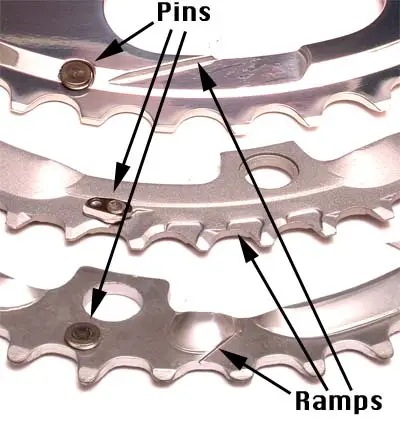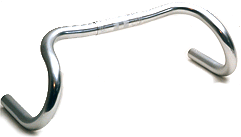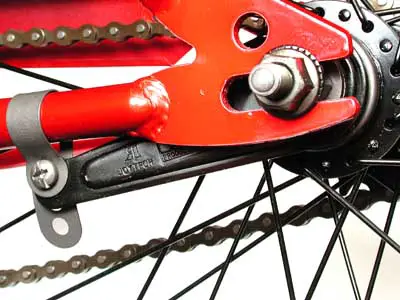Sheldon Brown's
Bicycle Glossary Ra - Re

|
![]()
Races in any of these categories may take the form of mass-start events or time trials. Additionally, there are some special types of track races with different formats.
In the case of conventional bicycle bearings, the races take the form of a cup and matching cone.
In cartridge bearings there is an inner and an outer race, usually both in the same plane as the balls.
 Radial spoking
Radial spoking Traditional cycling folklore holds that radial-spoked wheels give a "harsh" ride, due to the slightly shorter spokes they use. Jobst Brandt demolishes this fallacy nicely:
"...'radial spoking also gives you a very stiff wheel. You can actually feel increased bumpiness compared to a three- or four-cross wheel.'I would add that the deflection of the tire, the flex of the fork, stem and handlebars are each an order of magnitude greater than this theoretical deflection difference in the spokes. The difference in elasticity between spokes of different thicknesses is also much greater than the difference between spokes which differ in length by 3 %, but you don't hear the same complaints about wheels built with spokes of different thicknesses."I think you are imagining all this. There is no change in radial elasticity between a radial and crossed spoke wheel with the same components, other than the length of the spokes. A 290 mm spoke is 3% stiffer than a 300 mm spoke of the same type. Since spokes stretch elastically about 0.1mm on a hard bump (not ordinary road ripples), the elastic difference between the radial and cross-three wheel is 3% x 0.1mm = 0.003 mm. Copier paper is 0.075 mm thick, and if you can feel that when you ride over it on a glassy smooth concrete surface, please let me know. You have greater sensitivity than the lady in "the princess and the pea" fable.
"If your story weren't so common, I would assume it to be a put-on, but it isn't. I find it amazing how humans love to believe unbelievable things, the more unbelievable the stronger the belief. It isn't new."
Rake is one of the three factors that affect the trail of the bicycle, which has a considerable influence on the handling qualities.
A fork which is curved forward at the bottom also adds a small degree of suspension compared with one that is not, by acting as a leaf spring.
Raleigh had its own standards for threading and other dimensions, which were different from standard British dimensions. In particular,Raleigh used 26 threads/inch rather than 24, for headsets and bottom brackets. More information on older Raleighs is available in my article on English 3-speeds, and my Raleigh Sports Page.

Raleigh pattern rims are sometimes also referred to as "Westrick", which is a made-up word combining "Westwood" with "Endrick." Westwood rims were only for use with rod brakes; Endrick rims were only for use with caliper brakes; but Raleigh Pattern, a.k.a. "Westrick" rims can be used with either type.
They combine the raised (or dropped, depending how you look at it) center that keeps rod brake shoes free from the risk of hitting the spokes, with the flat sides required for rim brakes.
Raleigh Pattern rims are preternaturally strong, probably the strongest bicycle rims ever made. However, like all steel rims, they can get bumps on the sidewalls from pothole impacts an the like.
There is also a Schwinn copy of this design, seen on some older Schwinn 3-speeds. The Schwinn used the larger 597 mm bead seat, instead of the 590 used on most English 3-speeds.
![]()
![]()
| When Shimano introduced Hyperglide sprockets , one of the new features was "ramps" cut into the sides of the sprockets to facilitate shifting.
The ramps help to catch the side plates of the chain to lift it up when shifting to a larger sprocket. This worked so well on rear sprockets that it was later applied to chainwheels as well. Since chainwheels do their shifting with the tight segment of the chain, they are subject to more stress in shifting. In addition, chainrings are generally made of aluminum, which is softer than the hardened steel used on rear sprockets. Ramps on chainrings would get worn down easily and loose their effectiveness. To get around this problem, steel pins are commonly riveted into the sides of chainrings at the point of greatest stress. Ramped/pinned chainrings generally give improved shifting when moving from smaller to larger chainrings. The ramps and pins are always located on the side that faces the next smaller chainring. Ramps and pins are useless on the smallest chainring of a crankset, so they are normally found only on the outer rings. In addition to the ramps and pins, modern chainrings designed for derailer use often have the teeth in the area adjacent to the ramps cut with shorter peaks than the other teeth, again to facilitate upshifts. These features all help improve shifting, and make rider skill less important in shifting, but none of these features is actually essential to the functioning of any system. See also Pins & Ramps. |
 |
|---|
To be eligible to ride in major randonnées, a rider must qualify by riding a series of shorter randonnées called "brevets."
Randonneur
|
 |
 Shimano below-the-bar shift levers for upright handlebars. The original version of Rapidfire, introduced in the early '90's, had two thumb buttons, one above the other. One was for upshifting, the other for downshifting. Since the motion was the same for shifting in either direction, riders found it confusing, and it was quite unpopular.
Shimano below-the-bar shift levers for upright handlebars. The original version of Rapidfire, introduced in the early '90's, had two thumb buttons, one above the other. One was for upshifting, the other for downshifting. Since the motion was the same for shifting in either direction, riders found it confusing, and it was quite unpopular.
The newer generation, known as "Rapidfire Plus" uses a thumb button to shift to a larger sprocket, and an index-finger trigger to shift to a smaller one. This is a great ergonomic improvement, and Rapidfire Plus has been widely accepted.
A bicycle's freewheel has a ratchet which causes the sprocket to turn the wheel forward when the rider pedals forward, but allowing the wheel to turn forward even when the pedals are not being turned.
Ratchet wrenches turn a nut or bolt only when moved in one direction, leaving the nut or bolt in place when turned the other way, allowing the wrench to be used by swinging it back and forth, without having to lift it off the nut or bolt for the backswing.
A ratchet was also part of the Sun Tour Power Ratchet shift levers. Most ratchets use spring-loaded pawls to engaged a toothed ring for forward drive, while the teeth in the ring slide over the ends of the pawls when freewheeling.
![]()
![]()
This is usually measured along the forward extension of the stem, at whatever angle this turns out to be.
This is measured along the plane of the end section of the bar. The easiest way to measure this is to set the bars on a table or other flat surface, facing down. Use a book or other square reference to get the ends of the bar pointing straight up. Measure from the bottom of the middle section of the bar to the tabletop. Strictly speaking, reach is a center-to-center measurement, but with most bars the thickness is the same at the bend as it is near the middle (but not at the central bulge) so the thickness of the bar cancels out.
 The arm which connects a coaster brake or other hub brake to the chainstay or fork blade. It is designed to prevent the axle and other non-rotating parts of the hub from turning under the stress of braking. The reaction arm may be attached to the stay or fork blade either by a metal strap, or by a braze-on. The "Pacman" braze-on allows the wheel to be removed without having to un-bolt the reaction arm from the frame.
The arm which connects a coaster brake or other hub brake to the chainstay or fork blade. It is designed to prevent the axle and other non-rotating parts of the hub from turning under the stress of braking. The reaction arm may be attached to the stay or fork blade either by a metal strap, or by a braze-on. The "Pacman" braze-on allows the wheel to be removed without having to un-bolt the reaction arm from the frame.
The reaction arm usually resists forward rotation of the hub, but when holding a bicycle from rolling backward down a hill, it resists backward rotation. The metal strap shown in the photo with this entry is incorrectly installed. A reaction arm must be tightly clamped around the chainstay. Otherwise. the reaction arm will work back and forth and eventually loosen the strap bolt or axle nuts, resulting in brake failure. Some straps are made in different sizes, others have multiple holes like the one shown.
Some models of the Rohloff Speedhub use a reaction arm in place of anti-rotation washers to keep the hub's axle from rotating in the frame. (The gear range of the the Rohloff hub is so wide that simple anti-rotation washers would not be sufficient to withstand the axle torque in the extreme gears.)
Most newer good-quality bicycles that use caliper brakes use recessed mounting to save weight and for a more elegant appearance. Calipers intended for recessed mounting have much shorter center bolts, which do not extend all the way through the crown/bridge. Frames/forks designed for recessed mounting have stepped holes...6 mm in front, substantially larger at the back. Instead of a conventional hex nut that takes a 10 mm wrench, a cylindrical nut is used, which is broached for a 5 mm allen wrench.
See the article about caliper brakes for more detail, including advice on mounting recessed calipers on older frames
![]()
![]()
There are many different designs of recumbents. They fall into several classes which are known by arcane abbreviations:
Wheelbase categories:
| Recumbent Pros & Cons | |
|---|---|
| Pro | Con |
|
|
Reflectors alone are not sufficient for this purpose. Any bicycle used at night must have a headlight. This is the law, and common sense.
Although rear-facing reflectors are of some use, side and front reflectors accomplish nothing, since vehicles on a collision course with a moving bicycle don't have their headlights shining on the reflectors until it is already too late to avoid a collision.
There has been a long-running conspiracy among bicycle manufacturers to perpetuate the fiction that reflectors alone are enough for night riding. They have done this out of fear that they will be required to supply lights with new bicycles. For details, see:
The word "Regina" means"Queen" in Latin.
![]()
![]()
Restoration can get very expensive, and generally should only be done on valuable collectible machines that are intended for wall display, not for actual riding.
If you have a nice old bicycle that you actually want to ride (aside from the occasional parade) you are better off upgrading with newer parts.
 A retainer is a clip, usually of sheet-metal or plastic, that holds and separates the bearing balls in a ball bearing. The advantages of retainers are ease of assembly, and economy because the manufacturer can get by with fewer balls, if they are spaced apart by a retainer. Retainers are a good thing for one-piece cranks, due to the ease of assembly issue. Retainers also can make headsets easier to assemble, but on the other hand, using a larger number of loose balls to replace retainers can salvage a headset with indented bearing races, or prolong the life of a new headset. Retainers are used in cartridge bearings, to keep the balls spaced apart following assembly.: A cartridge bearing with both races in one plane could not be assembled if balls went more than halfway around. Retainers are generally not so good for other bicycle bearings.
A retainer is a clip, usually of sheet-metal or plastic, that holds and separates the bearing balls in a ball bearing. The advantages of retainers are ease of assembly, and economy because the manufacturer can get by with fewer balls, if they are spaced apart by a retainer. Retainers are a good thing for one-piece cranks, due to the ease of assembly issue. Retainers also can make headsets easier to assemble, but on the other hand, using a larger number of loose balls to replace retainers can salvage a headset with indented bearing races, or prolong the life of a new headset. Retainers are used in cartridge bearings, to keep the balls spaced apart following assembly.: A cartridge bearing with both races in one plane could not be assembled if balls went more than halfway around. Retainers are generally not so good for other bicycle bearings.
Conventional bottom brackets with loose balls can hold 11 1/4" balls per side. High quality retainer sets also have 11 balls. Cheaper retainers will only have 9 or even as few as 7 balls, and should not be used.
Sometimes it can be confusing to determine which side of a retainer faces which way, but careful examination of the retainer and the races it fits with will show the answer. The fundamental principle is that the retainer never touches either the cup or cone race, it only touches the balls. If a retainer is installed backwards, the retainer rubs and the bearing can not be adjusted.
Many cyclists consider these the finest "friction" type shift levers ever made.
With a pure friction lever, the friction has to at least equal the maximum pull of the derailer spring. When these are close, it takes almost no effort to push the lever forward (loosening the cable and the spring,) because the spring is helping you push the lever forward.
However, when you pull backward on the lever, tightening the cable, you are working against both the resistance of the friction clutch in the shift lever and the spring tension.
This creates an asymmetry of lever force between upshifting and downshifting.
With a "rétrofriction" system, a pawl-less ratchet disengages the friction clutch as you pull the lever backward, so you're only working against the spring. This gives a notably nicer feel to the shifter.
Other brands have solved this problem different ways. Shimano used to use a spring in the shifter that opposed the derailer's spring. This avoided the slightly "granular" feel created by the ratchet.
The popular Sun Tour "Power Ratchet " levers did something similar, using a ratchet and pawl system which made a slight clicking sound as you pulled back the lever.

![]()
![]()
![]()
Last Updated: by Harriet Fell